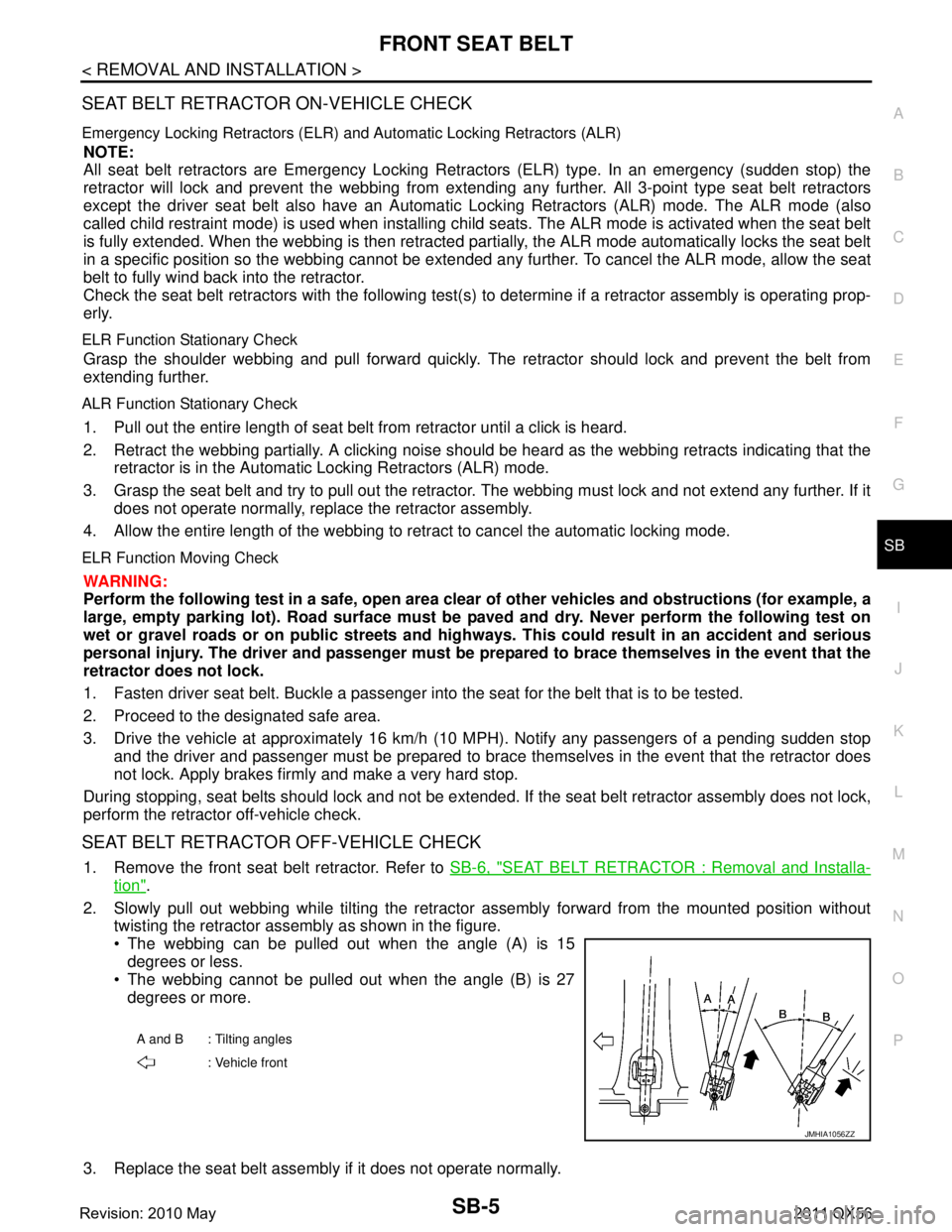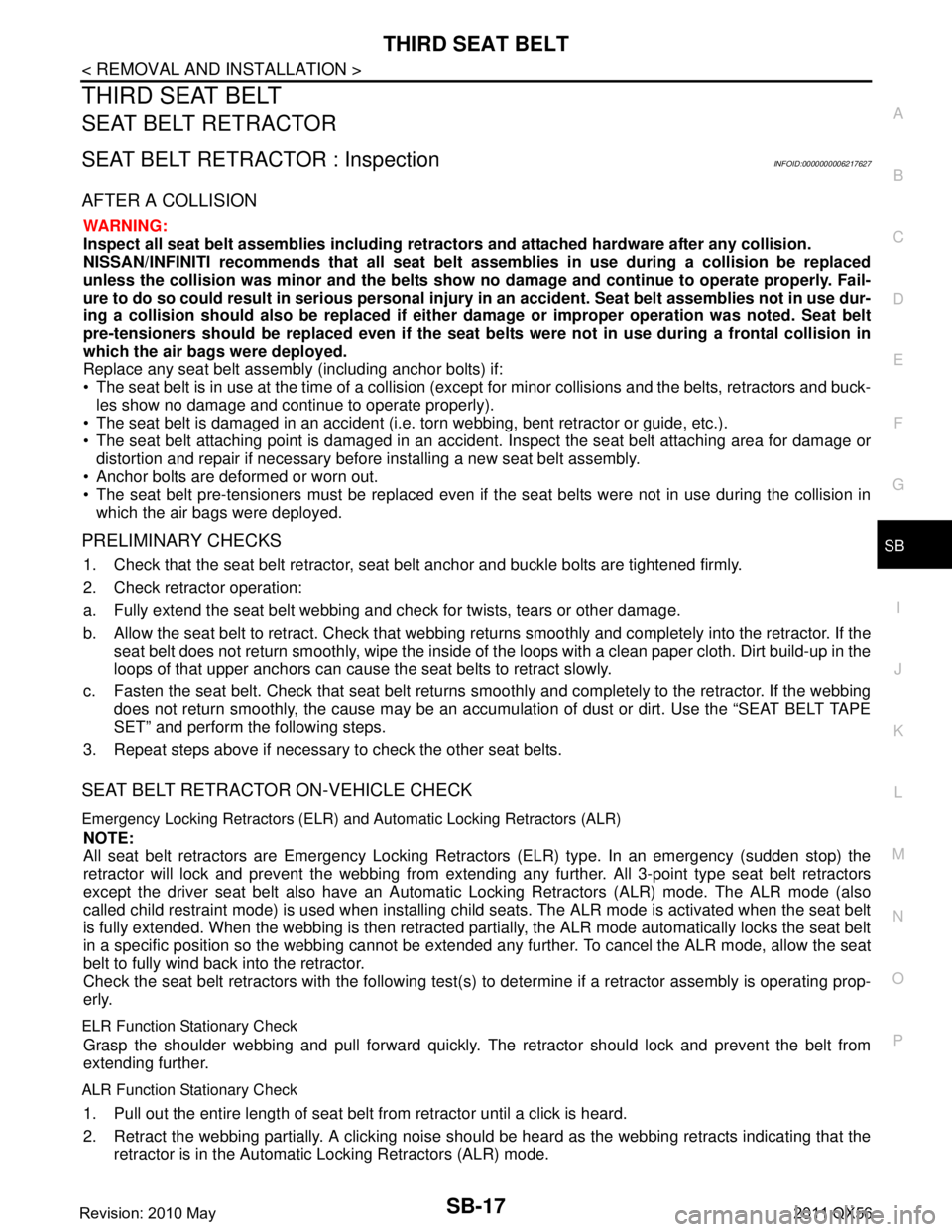child restraint INFINITI QX56 2011 Factory Service Manual
[x] Cancel search | Manufacturer: INFINITI, Model Year: 2011, Model line: QX56, Model: INFINITI QX56 2011Pages: 5598, PDF Size: 94.53 MB
Page 4276 of 5598

SB-1
RESTRAINTS
C
DE
F
G
I
J
K L
M
SECTION SB
A
B
SB
N
O P
CONTENTS
SEAT BELT
PRECAUTION ................ ...............................2
PRECAUTIONS .............................................. .....2
Precaution for Supplemental Restraint System
(SRS) "AIR BAG" and "SEAT BELT PRE-TEN-
SIONER" ............................................................. ......
2
Precaution Necessary for Steering Wheel Rota-
tion after Battery Disconnect .....................................
2
Precaution for Seat Belt Service ...............................3
REMOVAL AND INSTALLATION ................4
FRONT SEAT BELT ....................................... .....4
SEAT BELT RETRACTOR .................................... ......4
SEAT BELT RETRACTOR : Inspection ....................4
SEAT BELT RETRACTOR : Exploded View .............6
SEAT BELT RETRACTOR : Removal and Instal-
lation ..........................................................................
6
SEAT BELT BUCKLE ........................................... ......7
SEAT BELT BUCKLE : Inspection ............................7
SEAT BELT BUCKLE : Exploded View .....................8
SEAT BELT BUCKLE : Removal and Installation ......8
SECOND SEAT BELT ........................................10
SEAT BELT RETRACTOR .................................... ....10
SEAT BELT RETRACTOR : Inspection ..................10
SEAT BELT RETRACTOR : Exploded View ...........11
SEAT BELT RETRACTOR : Removal and Instal-
lation ........................................................................
13
SEAT BELT BUCKLE ............................................ ....14
SEAT BELT BUCKLE : Inspection ..........................14
SEAT BELT BUCKLE : Exploded View ...................14
SEAT BELT BUCKLE : Removal and Installation ....16
THIRD SEAT BELT ...........................................17
SEAT BELT RETRACTOR .................................... ....17
SEAT BELT RETRACTOR : Inspection ..................17
SEAT BELT RETRACTOR : Exploded View ...........19
SEAT BELT RETRACTOR : Removal and Instal-
lation ........................................................................
19
SEAT BELT BUCKLE ............................................ ....20
SEAT BELT BUCKLE : Inspection ..........................20
SEAT BELT BUCKLE : Exploded View ...................21
SEAT BELT BUCKLE : Removal and Installation ....21
LATCH SYSTEM FOR CHILDREN ...................22
Exploded View .........................................................22
Removal and Installation .........................................22
Revision: 2010 May2011 QX56
Page 4280 of 5598

FRONT SEAT BELTSB-5
< REMOVAL AND INSTALLATION >
C
DE
F
G
I
J
K L
M A
B
SB
N
O P
SEAT BELT RETRACTOR ON-VEHICLE CHECK
Emergency Locking Retractors (ELR) and Automatic Locking Retractors (ALR)
NOTE:
All seat belt retractors are Emergency Locking Retr actors (ELR) type. In an emergency (sudden stop) the
retractor will lock and prevent the webbing from extendi ng any further. All 3-point type seat belt retractors
except the driver seat belt also have an Automati c Locking Retractors (ALR) mode. The ALR mode (also
called child restraint mode) is used when installing child seats. The ALR mode is activated when the seat belt
is fully extended. When the webbing is then retracted part ially, the ALR mode automatically locks the seat belt
in a specific position so the webbi ng cannot be extended any further. To c ancel the ALR mode, allow the seat
belt to fully wind back into the retractor.
Check the seat belt retractors with the following test(s ) to determine if a retractor assembly is operating prop-
erly.
ELR Function Stationary Check
Grasp the shoulder webbing and pull forward quickly. The retractor should lock and prevent the belt from
extending further.
ALR Function Stationary Check
1. Pull out the entire length of seat bel t from retractor until a click is heard.
2. Retract the webbing partially. A clicking noise should be heard as the webbing retracts indicating that the
retractor is in the Automatic Locking Retractors (ALR) mode.
3. Grasp the seat belt and try to pull out the retractor. The webbing must lock and not extend any further. If it
does not operate normally, replace the retractor assembly.
4. Allow the entire length of the webbing to retract to cancel the automatic locking mode.
ELR Function Moving Check
WARNING:
Perform the following test in a safe, open area clear of other vehicles and obstructions (for example, a
large, empty parking lot). Road surface must be p aved and dry. Never perform the following test on
wet or gravel roads or on public streets and highways. This could result in an accident and serious
personal injury. The driver and passenger must be prepared to brace themselves in the event that the
retractor does not lock.
1. Fasten driver seat belt. Buckle a passenger into the seat for the belt that is to be tested.
2. Proceed to the designated safe area.
3. Drive the vehicle at approximately 16 km/h ( 10 MPH). Notify any passengers of a pending sudden stop
and the driver and passenger must be prepared to brac e themselves in the event that the retractor does
not lock. Apply brakes firmly and make a very hard stop.
During stopping, seat belts should lock and not be extended. If the seat belt retractor assembly does not lock,
perform the retractor off-vehicle check.
SEAT BELT RETRACTOR OFF-VEHICLE CHECK
1. Remove the front seat belt retractor. Refer to SB-6, "SEAT BELT RETRACTOR : Removal and Installa-
tion".
2. Slowly pull out webbing while tilting the retracto r assembly forward from the mounted position without
twisting the retractor assembly as shown in the figure.
The webbing can be pulled out when the angle (A) is 15
degrees or less.
The webbing cannot be pulled out when the angle (B) is 27
degrees or more.
3. Replace the seat belt assembly if it does not operate normally.
A and B : Tilting angles : Vehicle front
JMHIA1056ZZ
Revision: 2010 May2011 QX56
Page 4285 of 5598

SB-10
< REMOVAL AND INSTALLATION >
SECOND SEAT BELT
SECOND SEAT BELT
SEAT BELT RETRACTOR
SEAT BELT RETRACTOR : InspectionINFOID:0000000006217621
AFTER A COLLISION
WARNING:
Inspect all seat belt assemblies including retractors and attached hardware after any collision.
NISSAN/INFINITI recommends that all seat belt assemblies in use during a collision be replaced
unless the collision was minor and th e belts show no damage and continue to operate properly. Fail-
ure to do so could result in seri ous personal injury in an accident. Seat belt assemblies not in use dur-
ing a collision should also be re placed if either damage or improper operation was noted. Seat belt
pre-tensioners should be replaced even if the seat be lts were not in use during a frontal collision in
which the air bags were deployed.
Replace any seat belt assembly (including anchor bolts) if:
The seat belt is in use at the time of a collision (e xcept for minor collisions and the belts, retractors and buck-
les show no damage and continue to operate properly).
The seat belt is damaged in an accident (i.e. to rn webbing, bent retractor or guide, etc.).
The seat belt attaching point is damaged in an accident . Inspect the seat belt attaching area for damage or
distortion and repair if necessary before installing a new seat belt assembly.
Anchor bolts are deformed or worn out.
The seat belt pre-tensioners must be replaced even if t he seat belts were not in use during the collision in
which the air bags were deployed.
PRELIMINARY CHECKS
1. Check that the seat belt retractor, s eat belt anchor and buckle bolts are tightened firmly.
2. Check retractor operation:
a. Fully extend the seat belt webbing and c heck for twists, tears or other damage.
b. Allow the seat belt to retract. Check that webbing retu rns smoothly and completely into the retractor. If the
seat belt does not return smoothly, wipe the inside of the loops with a clean paper cloth. Dirt build-up in the
loops of that upper anchors can cause the seat belts to retract slowly.
c. Fasten the seat belt. Check that seat belt returns sm oothly and completely to the retractor. If the webbing
does not return smoothly, the cause may be an accumulation of dust or dirt. Use the “SEAT BELT TAPE
SET” and perform the following steps.
3. Repeat steps above if necessary to check the other seat belts.
SEAT BELT RETRACTOR ON-VEHICLE CHECK
Emergency Locking Retractors (ELR) and Automatic Locking Retractors (ALR)
NOTE:
All seat belt retractors are Emergency Locking Retr actors (ELR) type. In an emergency (sudden stop) the
retractor will lock and prevent the webbing from extendi ng any further. All 3-point type seat belt retractors
except the driver seat belt also have an Automati c Locking Retractors (ALR) mode. The ALR mode (also
called child restraint mode) is used when installing child seats. The ALR mode is activated when the seat belt
is fully extended. When the webbing is then retracted part ially, the ALR mode automatically locks the seat belt
in a specific position so the webbing cannot be extended any further. To cancel the ALR mode, allow the seat
belt to fully wind back into the retractor.
Check the seat belt retractors with the following test(s ) to determine if a retractor assembly is operating prop-
erly.
ELR Function Stationary Check
Grasp the shoulder webbing and pull forward quickly. T he retractor should lock and prevent the belt from
extending further.
ALR Function Stationary Check
1. Pull out the entire length of seat belt from retractor until a click is heard.
2. Retract the webbing partially. A clicking noise should be heard as the webbing retracts indicating that the retractor is in the Automatic Locking Retractors (ALR) mode.
Revision: 2010 May2011 QX56
Page 4292 of 5598

THIRD SEAT BELTSB-17
< REMOVAL AND INSTALLATION >
C
DE
F
G
I
J
K L
M A
B
SB
N
O P
THIRD SEAT BELT
SEAT BELT RETRACTOR
SEAT BELT RETRACTOR : InspectionINFOID:0000000006217627
AFTER A COLLISION
WARNING:
Inspect all seat belt assemblies in cluding retractors and attached hardware after any collision.
NISSAN/INFINITI recommends that all seat belt assemblies in use during a collision be replaced
unless the collision was minor and th e belts show no damage and continue to operate properly. Fail-
ure to do so could result in serious personal inju ry in an accident. Seat belt assemblies not in use dur-
ing a collision should also be replaced if either da mage or improper operation was noted. Seat belt
pre-tensioners should be replaced even if the seat be lts were not in use during a frontal collision in
which the air bags were deployed.
Replace any seat belt assembly (including anchor bolts) if:
The seat belt is in use at the time of a collision (exc ept for minor collisions and the belts, retractors and buck-
les show no damage and continue to operate properly).
The seat belt is damaged in an accident (i.e. to rn webbing, bent retractor or guide, etc.).
The seat belt attaching point is damaged in an accident . Inspect the seat belt attaching area for damage or
distortion and repair if necessary before installing a new seat belt assembly.
Anchor bolts are deformed or worn out.
The seat belt pre-tensioners must be replaced even if t he seat belts were not in use during the collision in
which the air bags were deployed.
PRELIMINARY CHECKS
1. Check that the seat belt retractor, seat belt anchor and buckle bolts are tightened firmly.
2. Check retractor operation:
a. Fully extend the seat belt webbing and check for twists, tears or other damage.
b. Allow the seat belt to retract. Check that webbing retu rns smoothly and completely into the retractor. If the
seat belt does not return smoothly, wipe the inside of t he loops with a clean paper cloth. Dirt build-up in the
loops of that upper anchors can cause the seat belts to retract slowly.
c. Fasten the seat belt. Check that seat belt returns sm oothly and completely to the retractor. If the webbing
does not return smoothly, the cause may be an accu mulation of dust or dirt. Use the “SEAT BELT TAPE
SET” and perform the following steps.
3. Repeat steps above if necessary to check the other seat belts.
SEAT BELT RETRACTOR ON-VEHICLE CHECK
Emergency Locking Retractors (ELR) and Automatic Locking Retractors (ALR)
NOTE:
All seat belt retractors are Emergency Locking Retr actors (ELR) type. In an emergency (sudden stop) the
retractor will lock and prevent the webbing from extendi ng any further. All 3-point type seat belt retractors
except the driver seat belt also have an Automati c Locking Retractors (ALR) mode. The ALR mode (also
called child restraint mode) is used when installing child seats. The ALR mode is activated when the seat belt
is fully extended. When the webbing is then retracted part ially, the ALR mode automatically locks the seat belt
in a specific position so the webbi ng cannot be extended any further. To c ancel the ALR mode, allow the seat
belt to fully wind back into the retractor.
Check the seat belt retractors with the following test(s ) to determine if a retractor assembly is operating prop-
erly.
ELR Function Stationary Check
Grasp the shoulder webbing and pull forward quickly. The retractor should lock and prevent the belt from
extending further.
ALR Function Stationary Check
1. Pull out the entire length of seat bel t from retractor until a click is heard.
2. Retract the webbing partially. A clicking noise should be heard as the webbing retracts indicating that the
retractor is in the Automatic Locking Retractors (ALR) mode.
Revision: 2010 May2011 QX56
Page 4805 of 5598

SRC-12
< SYSTEM DESCRIPTION >
SYSTEM
System Description
INFOID:0000000006219951
Supplemental Restraint System (SRS ) activates air bag module and seat belt pre-tensioner when it detects a
frontal collision or a side collision or rollover that is more than the specified limit. Together with other safety
devices, it reduces the impact that occup ant receives when vehicle collision occurs.
Air bag diagnosis sensor unit supplies power supply to air bag module and pre-tensioner seat belt when decel-
eration that is more than the specified limit is detec ted by G sensor in air bag diagnosis sensor unit, crash
zone sensor, or satellite sensor. Air bag module is composed of electric igniter (squib), filter, pyrotechnic mate-
rial, and gas generating material. When air bag module re ceives a signal from air bag diagnosis sensor unit,
air bag module ignites pyrotechnic material using electric igniter (squib) so that gas generating material gener-
ates high temperature nitrogen gas. The gas through filter activates air bag. At the same time, pre-tensioner
seat belt receives power supply from air bag diagnosis sensor unit, gasgenerator is activated, and then gas is
generated. Balls in pipe are moved according to generated gas pressure and strike pinion gear on ELR shaft.
ELR shaft rotates and retracts seat belt.
AIR BAG DIAGNOSIS SENSOR UNIT FUNCTIONS
Air bag diagnosis sensor unit has the following functions.
Detects a collision and supplies the energy for deploying air bag and seat belt pre-tensioner.
Detects and records electrical malfunction in air bag system and seat belt pre-tensioner system, and blinking
air bag warning lamp.
Detects and records the deployment of air bag and s eat belt pre-tensioner, and turns ON air bag warning
lamp.
Indicates malfunctioning portion via the number of blin ks from the air bag warning lamp in the diagnosis
mode.
Indicates the malfunction record via CONSULT-III.
COLLISION MODES
The operation of SRS is different depending on the collision modes applications.
SRS configurations that are activa ted for the following collision modes.
×: Apply —: Not apply
OCCUPANT DETECTION SYSTEM
This Occupant Detection System has the following functions.
1. Suppress the deployment of front passenger air bag w hen front passenger seat is empty, or when occu-
pied by child and child-seat. Turns ON front passenger air bag OFF indicator when front passenger seat is
occupied by child-seat and child.
2. Indicates malfunction portion with blinking times of air bag warning lamp in diagnosis mode.
3. Indicates the malfunctioning record by CONSULT-III.
4. When “zero point reset” for occupant detection system is incomplete, CONSULT-III indicates that “zero
point reset” is incomplete.
This function is applied to NISSAN genuine parts only.
NOTE:
SRS configuration Frontal collision Left side collision Right side collision Roll over
Driver air bag module ×———
Passenger air bag module ×———
Seat belt pre-tensioner LH ××—×
Seat belt pre-tensioner RH ×— ××
Lap pre-tensioner LH ××—×
Lap pre-tensioner RH ×— ××
Side air bag module LH — ×——
Side air bag module RH — — ××
Front curtain air bag module LH — ×— ×
Front curtain air bag module RH — — ××
Rear curtain air bag module LH — ×— ×
Rear curtain air bag module RH — — ××
Revision: 2010 May2011 QX56